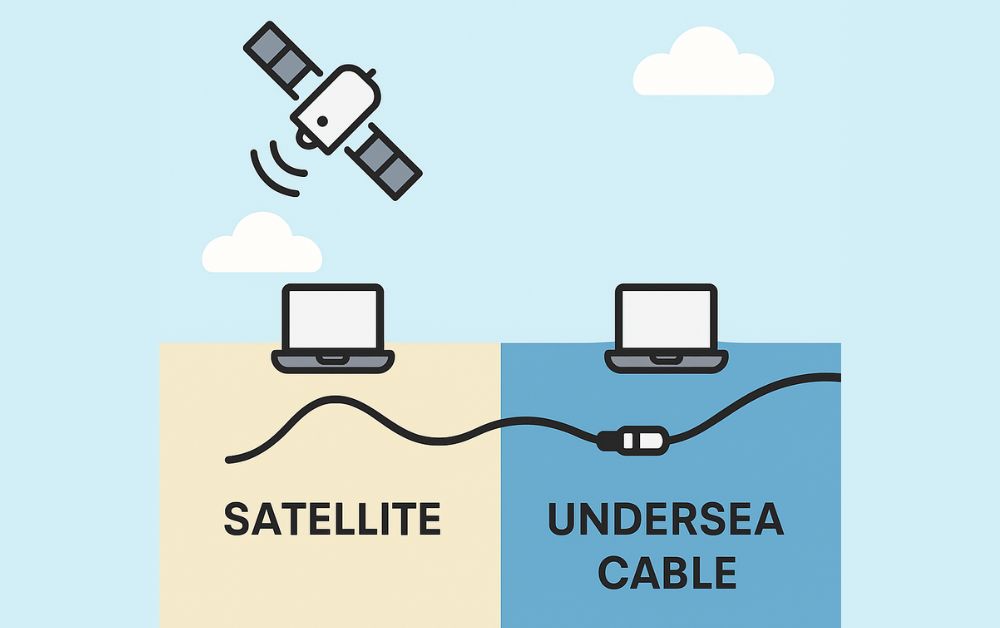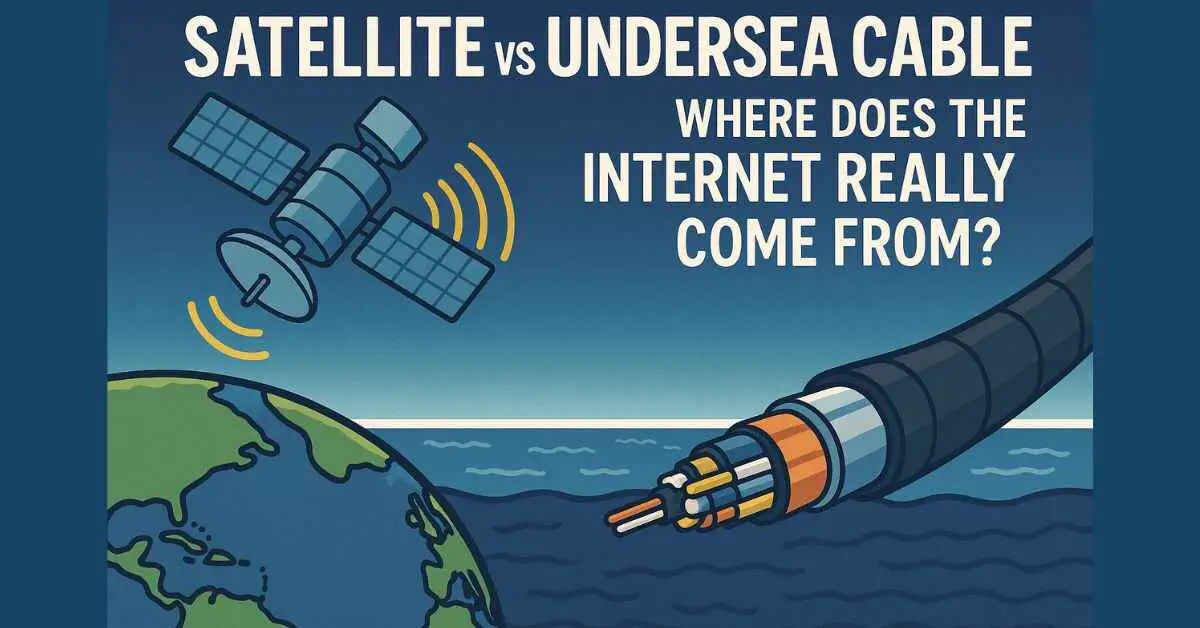🚀 Introduction: Internet — From the Sky or Under the Sea?
Have you ever wondered how the internet reaches your phone or computer?
Is it coming from satellites flying above Earth? Or from big underwater cables deep in the ocean?
It may sound surprising, but almost 99% of international internet data travels through undersea cables — not satellites.
In this article, we’ll explain:
- What is undersea cable internet?
- How satellite internet works
- Which one is better and why
- Fun facts and easy comparisons
Let’s dive in!
🌊 What Is Undersea Cable Internet?
Undersea cables are long fiber-optic wires that run across the ocean floor. They connect countries and continents, like India to the USA, Europe, or Australia.
These cables are fragile on the inside but protected by multiple layers to withstand harsh ocean conditions.
They carry data using laser light signals that move at the speed of light!
A single undersea cable can transfer more than 100 terabits of data per second. That’s millions of HD videos — every second!
What Is Satellite Internet?
Satellite internet uses big satellites placed in space. These satellites send internet signals directly to a dish antenna installed at your home or office.
Sounds futuristic, right? But satellite internet has some big limitations too.
Satellite vs Undersea Cable – A Simple Comparison

| Feature | Undersea Cable | Satellite Internet |
|---|---|---|
| 📶 Speed | Super Fast | Slower |
| ⏱️ Latency (Delay) | Very Low (10–20 ms) | High (400–700 ms) |
| 📡 Stability | Very Stable | Affected by weather |
| 💰 Cost per GB | Cheaper | Expensive |
| 🔒 Security | More Secure | Easier to hack |
| ⚙️ Maintenance | Repairable | Hard to fix if broken |
| 📍 Coverage | Global (via cable landings) | Useful in remote areas |
🤔 Why Don’t We Just Use Satellites?
That’s a smart question! Here’s why:
- Satellites are slower. They are thousands of kilometers away from Earth. So signals take time to travel.
- Limited bandwidth. Satellites can’t handle the huge amount of data traffic like cables do.
- Weather problems. Signals can be affected by rain, storms, or clouds.
- Expensive to launch. Building and sending a satellite to space costs millions of dollars.
That’s why undersea cables are the real backbone of the internet — even in 2025.
🌐 Real-World Examples
- Google, Facebook, and Amazon are building their own private undersea cables.
- India is connected to the world through cables like SEA-ME-WE 6, IAX, and AAE-1.
- Starlink (by SpaceX) is improving satellite internet, especially in remote villages — but it still can’t match the speed and cost of fiber cables.
🔮 The Future of Internet?
The future is hybrid.
✔️ Cities and countries will continue using fiber optic cables for speed and stability.
✔️ Remote areas like forests, deserts, and mountains will use satellite internet as a backup.
🧠 Conclusion: So, Where Does Your Internet Come From?
Next time you stream a movie or send a message to a friend in another country, remember:
It’s not magic.
It’s a powerful glass wire lying under the sea, carrying your data at the speed of light.
While satellite sounds cool, it’s the undersea cables that make the internet fast, affordable, and global.
Cloudflare Explained: Optimize Your Website’s Speed and Security
What Is IP Whitelist in CDN? Security Explained
Understanding Subnet Mask: A Beginner’s Guide
Arsalan Malik is a passionate Software Engineer and the Founder of Makemychance.com. A proud CDAC-qualified developer, Arsalan specializes in full-stack web development, with expertise in technologies like Node.js, PHP, WordPress, React, and modern CSS frameworks.
He actively shares his knowledge and insights with the developer community on platforms like Dev.to and engages with professionals worldwide through LinkedIn.
Arsalan believes in building real-world projects that not only solve problems but also educate and empower users. His mission is to make technology simple, accessible, and impactful for everyone.



